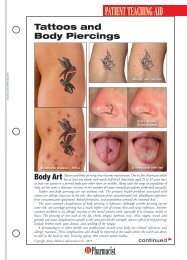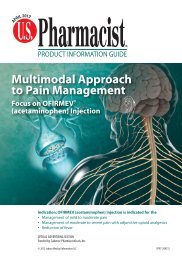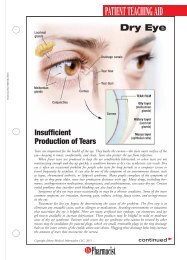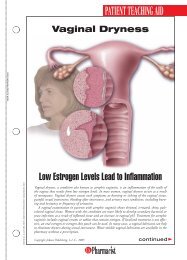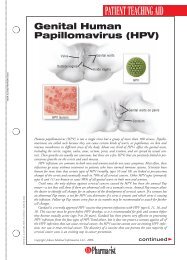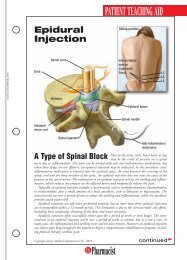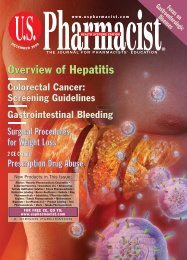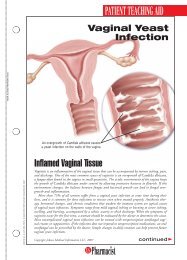2 CE CreditsThis activity is supported by an educational grant fromTeva Women’s Health.© JUPITERIMAGESEmergencyContraceptionAn Update of Clinicaland Regulatory ChangesEmergency contraception (EC),sometimes referred to as the“morning-after pill,” is a safeand effective method of preventingpregnancy after intercourse. Levonorgestrel,a hormone found in manybirth control pills, is the active ingredientin most emergency contraceptiveproducts used in the U.S. TheFood and Drug Administration (FDA)approved the first levonorgestrel-onlyemergency contraceptive, Plan B (levonorgestrel0.75 mg oral tablets), in1999 for prescription use. In 2006,the FDA widened access to EC byapproving over-the-counter (OTC)sale to consumers 18 years of age orolder. 1,2 At the time, Plan B was thefirst product to be approved in theU.S. with dual status (a single productapproved for OTC sale or prescription-onlyaccess to consumersbased on age). More recently, the FDAfurther increased access to EC byreducing the age for OTC access toanyone 17 years and older, continuingaccess to girls under age 17 byprescription only. Two new EC productsrecently became available inthe U.S. In July 2009, the FDAapproved a one-dose emergency contraceptive,Plan B One-Step (levonorgestrel1.5 mg tablet) for OTCKathleen H. Besinque, PharmD, MSEdAssociate Professor of Clinical PharmacySchool of PharmacyUniversity of Southern CaliforniaLos Angeles, CaliforniaU.S. <strong>Pharmacist</strong> Continuing EducationGOAL: The goals of this educational program are to update pharmacists and other healthcare professionals on the current clinical and regulatory information related to levonorgestrelbasedemergency contraception and to provide effective strategies for educating consumersabout emergency contraception.OBJECTIVES: After completing this activity, participants should be able to:1. Discuss the clinical indications for emergency contraception.*2. Compare available levonorgestrel-only emergency contraceptive regimens and therequirements associated with the nonprescription sale of these products.*3. Describe the evidence for the mechanism of action and safety profile of levonorgestrel-onlyemergency contraceptive regimens.*4. Discuss opportunities for pharmacists to provide improved access to emergency contraception,including identification of and reduction of barriers in the pharmacy environment.*5. Describe strategies to improve education and counseling of consumers regarding theeffective use of levonorgestrel emergency contraception regimens.** Also applies to pharmacy technicians.sale to consumers age 17 and olderand by prescription to girls under age17. 3 Next Choice (levonorgestrel 0.75mg tablets) was also approved in 2009and is a generic formulation of theoriginal Plan B. Although three levonorgestrelEC products may be currentlyavailable—Plan B, Plan B One-Step, and Next Choice— the distributionof Plan B will cease as Plan B One-Step launches into the marketplace.All EC products are approved to preventpregnancy when a contraceptivemethod has failed or was not usedduring intercourse.Unintended pregnancies are associatedwith many personal and publichealth related consequences. Inthe U.S., approximately half of allpregnancies occurring each year areunintended and as many as half ofthe unintended pregnancies are terminatedby elective abortion. 4 Whentaken within 72 hours of unprotectedintercourse, levonorgestrel-only ECreduces the risk of pregnancy by asmuch as 89%. 2,3 Studies to date havenot been able to show that havingEC available without a prescriptionhas reduced the rates of unintendedpregnancy in the U.S. as was originallyanticipated. 5,6 The reason forthe lower-than-anticipated impact onunintended pregnancy rates may berelated to the persistence of barriersto EC access, including misunderstandingby consumers about whento use EC.<strong>Pharmacist</strong>s and other health careprofessionals can help to reduce bar-70U.S. <strong>Pharmacist</strong> • November 2009 • www.uspharmacist.com
Table 1Early Barriers PreventingUtilization of EC Methods• Lack of awareness by consumers that a method toprevent pregnancy after intercourse was available• Failure of doctors to discuss EC during medicalappointments• Lack of information about EC among health careprofessionals• Misconceptions about how EC works• Confusion of EC and the “abortion pill”• Difficulty obtaining EC by prescription within thenarrow window of efficacyriers that limit the use of EC by improving patient accessand being available to answer questions about the useof EC. <strong>Pharmacist</strong>s, as the “most accessible” healthcare provider, are in a unique position and play a crucialrole in providing timely access to and informationabout EC to consumers. OTC availability in the pharmacyto consumers age 17 and over improves access toEC by reducing the delays that were associated withobtaining a prescription in the limited time frame neededfor efficacy of the product.EMERGENCY CONTRACEPTION: AN UPDATETable 2Products Approved for Emergency ContraceptionLevonorgestrelBrand Manufacturer Dose per Dose (mg)One-Dose RegimenPlan B One-Step Barr Pharmaceuticals 1 tablet per dose 1.5Two-Dose Regimens (administered immediately and 12 h later)Plan BBarr PharmaceuticalsNext Choice Watson Pharmaceuticals 1 tablet per dose 0.75Background and Clinical History of ECLevonorgestrel has been extensively studied as anemergency contraceptive worldwide since the 1970s.After almost 40 years of EC use, the high degree ofefficacy in preventing pregnancy (up to 89% reduction)and the low rate of adverse effects have been well documented.5,7-10 A 2009 update to a Cochrane review ofEC interventions included more than 88 studies andconcluded that levonorgestrel is both safe and effectivein preventing pregnancy after intercourse. 7The first products approved by the FDA for EC werePreven (ethinyl estradiol 0.25 mg/levonorgestrel 0.5 mgtablets) in 1998 and Plan B (levonorgestrel 0.75 mgtablets) one year later. Both products were approved foruse by prescription and to be taken in a two-dose regimeninitiated within 72 hours of unprotected intercourse.Despite FDA approval, an increase in the utilizationof EC by women was hampered by a numberof barriers (TABLE 1).To improve access, a request was made to move PlanB to OTC status. Plan B appeared to satisfy FDA requirementsfor conversion from prescription to OTC status,which include a minimum of two years of prescriptionuse with a high degree of safety and studies establishingthat consumers can interpret labeled instructions correctly.Although an FDA Advisory Committee voted in2003 in support of the request for nonprescriptionstatus, the FDA approved a change for Plan B in 2006to “dual status” instead. 11 Under dual status, Plan B wasmade available without prescription to consumers at orabove a certain age (originally 18 years but now 17) andremained available by prescription to younger women.Packaging for the product was approved to meet therequirements for both prescription and nonprescriptionproducts. Since then, Next Choice and Plan B One-Step have also been approved for dual status distributionin pharmacies and clinics (TABLE 2).Before the approval of dedicated products for EC,commercially available oral contraceptives containingethinyl estradiol with either norgestrel or levonorgestrel(often referred to as the “Yuzpe regimen”) were used forEC. More recent studies have shown these combinationsto be less effective (ranging from 49% to 75%)than levonorgestrel-only regimens. 7,9 Furthermore,the Yuzpe regimen has more side effects, especially nauseaand vomiting, which often require the addition ofan antiemetic medication. Production of Preven, a commerciallyavailable equivalent to the Yuzpe regimen, wasstopped in 2004. Because of its lower efficacy andincreased frequency of side effects, use of the Yuzpe typecombination regimens has declined but remains anoption when levonorgestrel is not available.Several other methods have been evaluated for EC,including combinations of estrogen with norethindrone,combining levonorgestrel with the COX-2 inhibitormeloxicam, Yuzpe or levonorgestrel regimens using differenttime intervals or doses, insertion of a copper IUD,an investigational progesteronemodulator ulipristal (availableas ellaOne in Europe) andlow doses of mifepristone. 7,12Combination regimens usingnorethindrone appear to be lesseffective than levonorgestrelregimens. 13 Regimens usingmifepristone in doses rangingfrom 10 mg to 50 mg appearto be effective; however, thesedoses are not available in theU.S. 7 Insertion of a copper IUDup to 10 days after intercourse71U.S. <strong>Pharmacist</strong> • November 2009 • www.uspharmacist.com




